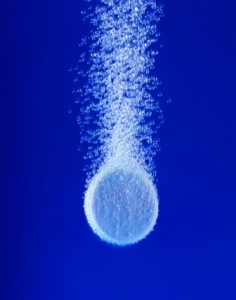News
10th March 2020 - Formulation Spray Dried Dispersions into Tablets
In this article, Upperton interviewed Dr Ian Lafferty, our Technical Consultant on the topic of developing spray dried dispersions (SDDs) into tablets.
Ian has 25 years of technical and operational experience in early phase pharmaceutical development encompassing the formulation design, development, process optimisation and manufacture of a wide range of dosage forms including oral solids; with a focus on challenging molecules and enabling technologies, especially in the application of spray drying to enhance the bioavailability of poorly water soluble drug substances.
Interview
What has been the driving force for the growth of interest in amorphous solid dispersions?
Oral solid dosage forms such as tablets and capsules remain the most widely used method for delivering drug products to patients due to factors including their ease of administration and established manufacturing processes. However, dissolution of the dosage form and solubility of the drug are critical parameters in determining how much of the drug substance become biologically available. It is well documented that the majority of new drug substances are classified as poorly water soluble and as such they require the application of an enabling formulation technology to enhance their solubility and bioavailability in order for them to be effective drug products. Several techniques exist to enable the drug product such as nanomilling, complexation with cyclodextrins incorporation into emulsification systems and the formation of amorphous solid dispersions.
What are amorphous solid dispersions (ASD)?
In pharmaceutical terms the use of amorphous solid dispersions is a well-established but still developing strategy for improving the solubilisation and bioavailability of poorly water-soluble drug substances. Amorphous and crystalline solids present different chemical structures. Crystalline solids have an ordered and repeating long-range arrangement of atoms or molecules within the structure, whereas amorphous solids lack an ordered long-range arrangement. This change in structure results in the same materials having very different properties such as melting point and solubility. A solid is more stable in its crystalline form and typically under the right conditions an amorphous solid will revert to its crystalline state and therefore requires stabilisation to remain in its amorphous form.

How are ASDs produced?
The poorly water soluble (crystalline) drug substance is solubilised in a suitable solvent with a polymer to form a solution. When the solvent is removed the drug substance, in it’s now solubilised “less ordered” form, is trapped in a solid polymer dispersion. To produce a stable ASD you must choose the correct polymer, drug – polymer ratio, solvent and processing conditions. The resulting ASD will show improved water solubility, suitable for further processing into a pharmaceutical dosage form.
The most popular methods utilised within the pharmaceutical industry for the development of ASDs are spray drying (spray dried dispersions – SDD), and hot melt extrusion, while milling a drug substance along with a polymer is also being increasingly investigated.
What advantages does spray drying bring over other techniques?
Spray drying technology is a well-established process for producing an SDD. The drug – solvent solution is easily sprayed into fine droplets and the solvent rapidly evaporated leaving a solid drug polymer particle with the drug in an amorphous state. Spray drying technology is well understood, process parameters are easily controlled, and equipment is available in a wide range of scales. The process is relatively straightforward to scale-up and it is a continuous process meaning it is highly efficient. Due to mechanism of evaporation involved in spray drying, even temperature sensitive molecules can be processed despite the high inlet temperatures used (typically as high as 150°C). Whereas in hot melt extrusion the material is held for prolonged periods at the high temperatures making it unsuitable for many compounds. The output material from spray drying is generally in a form (dry powder) that can be easily formulated and processed into conventional dosage forms such as tablets and capsules.
How can spray dried material be converted into a dosage form?
Spray dried powder can be readily formulated into a range of dosage forms. The chosen dosage form will depend on many factors. The target product profile must be considered carefully. Formulating the powder as a simple powder in a bottle or powder in a sachet may be more suitable for delivering the product to paediatric patients or patients who have difficulty swallowing. Tablets and capsule offer a range of advantage as such as accuracy and control of dosing. Capsules offer advantages such as masking taste or odour and fewer process steps while tablets will offer greater flexibility for incorporation of high doses.
What are the challenges that come with developing SDDs into tablets – and how might you overcome them?
Spray dried dispersions (SDDs) present several challenges to the formulator developing a tablet dosage form. These include the low density of spray dried powder which typically has poor flow properties meaning that a densification process such as dry granulation will be required. Another challenge can be ensuring that the tablets can disintegrate quickly and that the dissolution profile of the drug substance meets the required specification. The fact that the SDD requires the inclusion of a polymer to stabilise the drug in its amorphous state is often counterproductive when trying to manufacture an immediate release tablet that disintegrates quickly. The polymers by their nature will bind the tablet and can inhibit disintegration / dissolution. This requires careful control of other excipients (e.g. disintegration and wicking agents) and of compression processing parameters.
Other factors that need to be evaluated include ensuring that the stability of the amorphous spray dried dispersion is not adversely affected by processing conditions during granulation, compression and film coating.
As you scale up SDDs, do they provide any challenges in tabletting?
As with all tablet formulations scaling-up presents a variety of processing challenges that should be investigated and evaluated as soon as possible by a designed set of experiments. Particular challenges presented by SDDs, will include the effect of compression parameters such as speed, dwell time, compression force on the disintegration of the tablets and dissolution of the drug substance. The potential for over lubrication and the effect of double lubrication can also be an issue. Typically, the SDD powder will be roller compacted with a lubricant to create a free-flowing granule suitable for compression and the final tablet blend will also be lubricated to aid processing. This double lubrication can easily result in over-lubrication affect release of the drug from the granule.
Film coating SDD based tablets also requires careful control and monitoring as the moisture, humidity and heat involved in the coating process all have the potential to destabilise the amorphous nature of the SDD.
Are there specific analytical tests required for tablets manufactured with SDDs?
As with all tablets, standard QC tests will include assay, related substances and dissolution testing but in the case where the tablet comprises of a SDD there are some specific performance specifications that need to be tested and monitored.
The degree of crystallinity is clearly an important factor for SDDs, the purpose of creating the ASD is to reduce or eliminate the degree present in the drug substance. Techniques useful in qualifying the degree of crystallinity are therefore required to perform both release and stability testing of the final dosage form. Techniques such as Powder X-ray diffraction (PXRD), differential scanning calorimetry (DSC) and polarised light microscopy (PLM) have become the standard techniques for characterising amorphous solid dispersion dosage forms.
As improved solubility is a primary objective of forming a SDD, dissolution testing in the relevant key performance test. Processing conditions for example during coating and storage conditions will clearly challenge the stability of a SDD and therefore careful on-going monitoring of the crystallinity and dissolution profiles are important stability indicative tests.
What are common questions clients ask about SDDs?
Initially clients are concerned about how their drug substance will survive the high temperatures used in spray drying but as mentioned previously the evaporative cooling effect that is characteristic of spray drying means that this is rarely an issue. Drug loading (i.e. how much drug can be incorporated into an SDD), what solvent, what polymer and how scalable is the process are also key concerns for clients.
How do Upperton mitigate these concerns?
At Upperton we will always tailor the project to meet the client’s requirements, stage of development and availability of drug substances. Typically, the first stages in development an SDD will be to perform a range of screening experiments to identify the most appropriate solvent, polymer and drug to polymer ratio. A series of prototype spray dried dispersions (SDDs) will be manufactured and testing them for amorphicity (lack of crystallinity) and solubility. Promising SDDs will then be stability tested at a range of stressed conditions and a small number of lead formulations selected for further development, scale-up and dosage form processing.
These lead SDDs can be evaluated using in vitro methods such as dissolution testing or can be incorporated into Upperton’s UpperSolv™ protocol whereby small animal pharmacokinetic evaluation can be used to quickly identify a lead candidate for clinical development.
Upperton have a wide range of spray drying equipment in both a pilot facility and a GMP facility that can be used to scale the process from milligrams to kilograms using well established world leading spray drying equipment.
